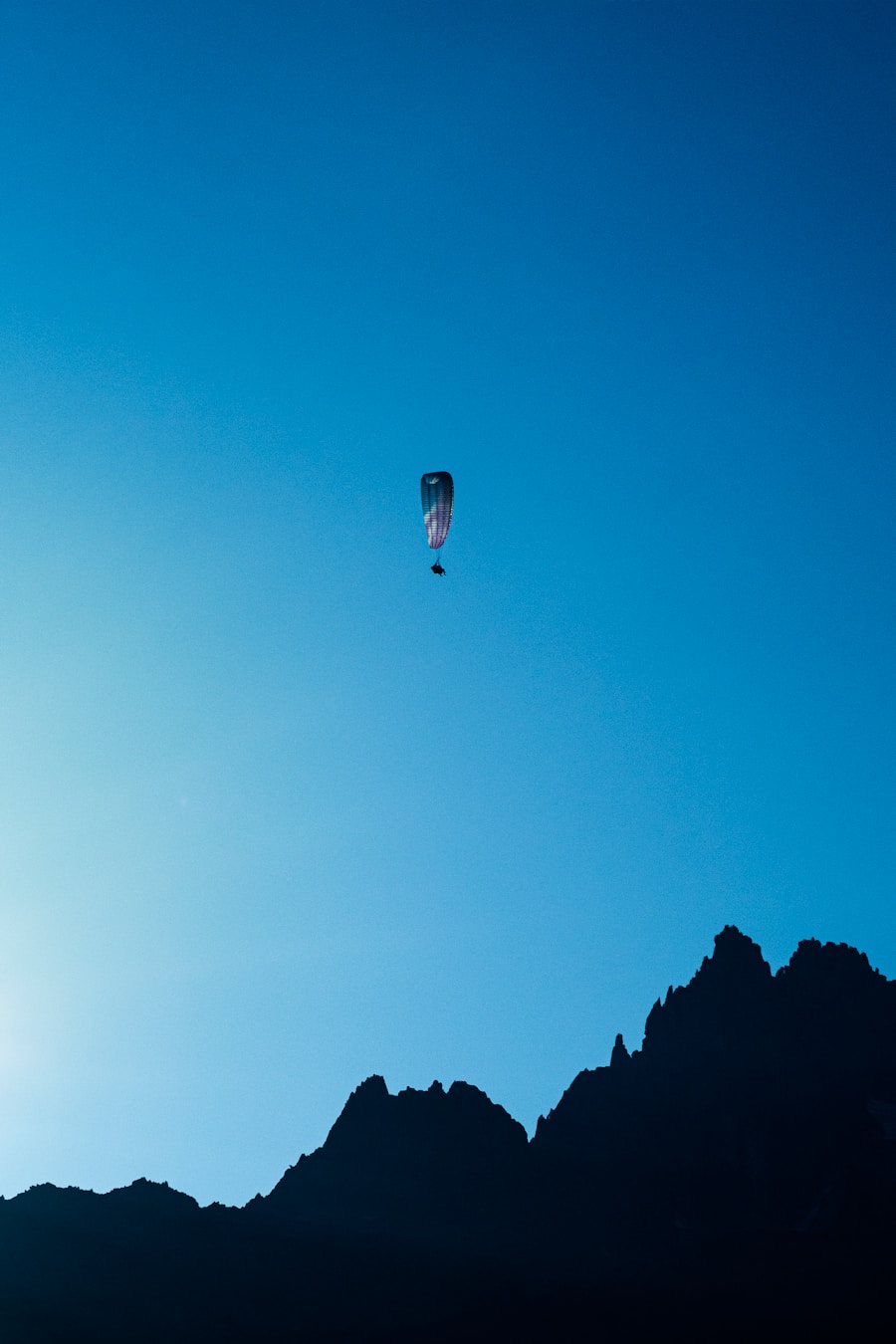Download links
How to install Soaring to New Heights: The Thrilling Adventure of Wingsuit Flying APK?
1. Tap the downloaded Soaring to New Heights: The Thrilling Adventure of Wingsuit Flying APK file.
2. Touch install.
3. Follow the steps on the screen.
Description
Wingsuit flying, a breathtaking blend of human ingenuity and the desire for flight, has a rich history that dates back to the early 20th century. The concept of gliding through the air with a suit designed to enhance lift and control can be traced to the pioneering work of early aviators and inventors. One of the first recorded instances of wingsuit-like designs was in 1912 when a French inventor named Franz Reichelt attempted to fly using a parachute suit he designed.
Although his tragic attempt ended in failure, it laid the groundwork for future innovations in human flight. The idea of using fabric to create lift and control during freefall captured the imagination of many, leading to various experimental designs throughout the decades. The modern era of wingsuit flying began in the late 1990s, when skydivers started to experiment with specialized suits that allowed for greater maneuverability and extended flight time.
The first commercially available wingsuits were developed by pioneers like Patrick de Gayardon and Jari Kuosma, who recognized the potential for a new form of aerial sport. De Gayardon’s design, which featured fabric wings between the arms and legs, allowed for a significant increase in horizontal distance traveled during freefall. This innovation marked a turning point in the sport, as it transformed wingsuit flying from a niche activity into a popular extreme sport.
As more enthusiasts embraced this thrilling pursuit, wingsuit flying began to gain recognition in the skydiving community and beyond.
Key Takeaways
- Early innovations in wingsuit flying can be traced back to the 1930s, with modern advancements leading to the development of the wingsuit as we know it today.
- Understanding the physics of wingsuit flying involves concepts such as lift, drag, and the angle of attack, which all contribute to the thrill and excitement of the sport.
- Training and safety measures are crucial for wingsuit flying, with extensive preparation and ongoing practice necessary to ensure a safe and exhilarating experience.
- From the Swiss Alps to the Grand Canyon, there are numerous breathtaking locations around the world that offer the perfect backdrop for wingsuit flying adventures.
- The evolution of wingsuit technology has seen significant changes in gear and equipment, with advancements in materials and design enhancing performance and safety for wingsuit flyers.
- The future of wingsuit flying holds the promise of pushing boundaries and breaking records, with ongoing innovation and exploration driving the sport to new heights.
The Physics of Wingsuit Flying: Understanding the Science Behind the Thrill
The Science of Lift and Drag
The wingsuit creates lift by increasing the surface area exposed to the airflow, allowing the flyer to glide rather than plummet straight down. The key to successful wingsuit flying lies in understanding the balance between lift and drag. Lift is generated by the air flowing over and under the wings of the suit, while drag is the resistance encountered as the flyer moves through the air.
Optimizing Performance
A well-designed wingsuit maximizes lift while minimizing drag, enabling flyers to achieve impressive horizontal distances. For instance, experienced wingsuit pilots can cover several miles horizontally while descending just a few thousand feet vertically.
An Exhilarating Experience
This unique combination of gliding and falling creates an exhilarating experience that is both thrilling and scientifically intriguing.
Training and Safety Measures: Preparing for the Ultimate Adrenaline Rush

Before embarking on a wingsuit flying adventure, aspiring pilots must undergo rigorous training to ensure their safety and proficiency in the air. Most wingsuit flyers begin their journey with a solid foundation in skydiving, accumulating hundreds of jumps before even considering transitioning to wingsuit flying. This prerequisite is crucial, as it allows individuals to develop essential skills such as body control, awareness of altitude, and emergency procedures.
Many training programs emphasize the importance of mastering basic skydiving techniques before introducing wingsuit-specific maneuvers. Safety measures are paramount in wingsuit flying due to the inherent risks associated with high-speed descents and complex aerial maneuvers. Flyers are encouraged to use advanced safety equipment, including automatic activation devices (AADs) that deploy parachutes at predetermined altitudes if the pilot fails to do so manually.
Additionally, many wingsuit pilots participate in group jumps with experienced instructors who can provide guidance and support during training sessions. These safety protocols are designed to minimize risks and ensure that participants can enjoy the thrill of wingsuit flying while prioritizing their well-being. Source: Skydive Mag
Exploring the Best Wingsuit Flying Locations Around the World
| Location | Altitude (feet) | Flight Time (minutes) | Distance (miles) |
|---|---|---|---|
| Chamonix, France | 12,605 | 5 | 15 |
| Lauterbrunnen, Switzerland | 9,744 | 4 | 12 |
| Zhangjiajie, China | 4,265 | 3 | 8 |
| Rio de Janeiro, Brazil | 7,717 | 4 | 10 |
| Perrine Bridge, USA | 486 | 2 | 3 |
Wingsuit flying enthusiasts are fortunate to have access to some of the most breathtaking locations on Earth for their aerial adventures. One of the most iconic spots is Lauterbrunnen Valley in Switzerland, renowned for its stunning cliffs and picturesque landscapes. The valley’s towering rock faces provide an ideal backdrop for wingsuit pilots seeking both beauty and challenge.
Another popular destination is the stunning fjords of Norway, where dramatic cliffs plunge into deep blue waters. Locations like Kjerag and Preikestolen attract wingsuit flyers from around the globe, drawn by the combination of breathtaking scenery and exhilarating flight opportunities.
The unique geography allows for long glides over stunning landscapes, making each jump an unforgettable experience. In addition to these natural wonders, urban environments like Dubai have also become hotspots for wingsuit flying, with pilots leaping from skyscrapers and gliding through cityscapes, showcasing their skills against a backdrop of modern architecture.
The Evolution of Wingsuit Technology: How Gear and Equipment Have Changed Over Time
The evolution of wingsuit technology has been instrumental in shaping the sport as we know it today. Early wingsuits were often rudimentary in design, constructed from basic materials that limited performance and safety. However, advancements in fabric technology and aerodynamics have led to significant improvements in modern wingsuits.
Today’s suits are crafted from lightweight yet durable materials that enhance both performance and comfort during flight. Modern wingsuits feature intricate designs that optimize airflow and control during freefall. Innovations such as adjustable wing surfaces allow pilots to fine-tune their suits for specific conditions or personal preferences.
Additionally, advancements in harness systems have improved safety and ease of use, enabling pilots to focus on their flight rather than struggling with cumbersome gear. The integration of technology into wingsuit design has not only enhanced performance but also made the sport more accessible to newcomers eager to experience the thrill of flight.
The Future of Wingsuit Flying: Pushing Boundaries and Breaking Records

As wingsuit flying continues to gain popularity, enthusiasts are constantly pushing the boundaries of what is possible in this exhilarating sport. Record-breaking jumps have become a hallmark of wingsuit flying culture, with pilots striving to achieve new heights—both literally and figuratively. For instance, in 2016, world-renowned wingsuit pilot Jeb Corliss completed a remarkable jump from a height of 12,000 feet over Table Mountain in South Africa, showcasing not only his skill but also the potential for extreme feats within this discipline.
Looking ahead, advancements in technology are likely to play a pivotal role in shaping the future of wingsuit flying. Innovations such as improved materials for suits and enhanced safety equipment will continue to enhance performance while prioritizing pilot safety. Furthermore, as more individuals become interested in this thrilling sport, we can expect an increase in organized competitions and events that celebrate both skill and creativity in wingsuit flying.
As boundaries are pushed and records are broken, wingsuit flying will undoubtedly continue to captivate audiences around the world, inspiring future generations to take to the skies in pursuit of their own aerial dreams.
Check out this article to learn more about the game and how it has become a global phenomenon.
FAQs
What is wingsuit flying?
Wingsuit flying is a type of skydiving where the participant wears a specialized jumpsuit that adds surface area to the body, enabling a significant increase in lift. This allows the person to glide through the air like a bird.
How does a wingsuit work?
A wingsuit works by creating additional surface area with fabric between the arms and body, as well as between the legs. This increased surface area generates lift, allowing the wearer to glide through the air rather than simply free-falling.
What are the risks of wingsuit flying?
Wingsuit flying carries inherent risks due to the high speeds and proximity to the ground or other objects. Accidents can occur due to collisions, loss of control, or failure to deploy the parachute in time. It is considered an extreme sport and should only be attempted by experienced skydivers.
What training is required for wingsuit flying?
To participate in wingsuit flying, individuals must first become certified skydivers and gain experience in traditional skydiving. They then undergo specialized wingsuit training to learn the techniques and safety procedures specific to wingsuit flying.
Where can wingsuit flying be done?
Wingsuit flying can be done at various skydiving locations around the world, typically in areas with suitable terrain and airspace for the activity. Some popular locations for wingsuit flying include the Swiss Alps, the Dolomites in Italy, and the mountains of Norway.





